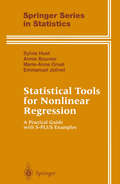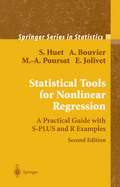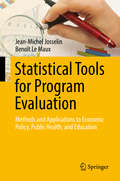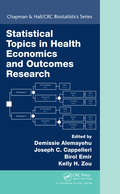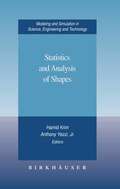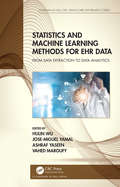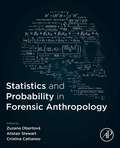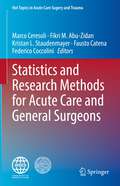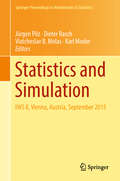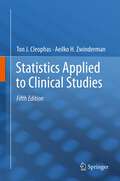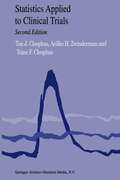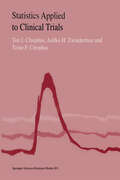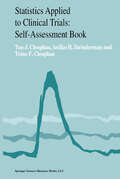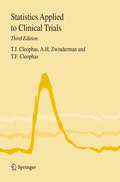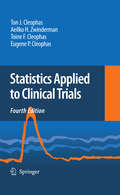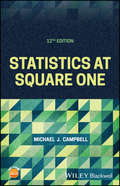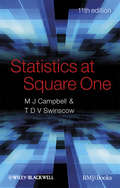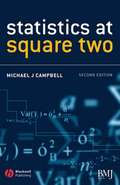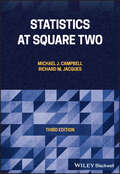- Table View
- List View
Statistical Tools for Nonlinear Regression: A Practical Guide with S-PLUS Examples (Springer Series in Statistics)
by Sylvie Huet Anne Bouvier Marie-Anne Poursat Emmanuel JolivetStatistical Tools for Nonlinear Regression presents methods for analyzing data. It has been expanded to include binomial, multinomial and Poisson non-linear models. The examples are analyzed with the free software nls2 updated to deal with the new models included in the second edition. The nls2 package is implemented in S-PLUS and R. Several additional tools are included in the package for calculating confidence regions for functions of parameters or calibration intervals, using classical methodology or bootstrap.
Statistical Tools for Nonlinear Regression: A Practical Guide With S-PLUS and R Examples (Springer Series in Statistics)
by Sylvie Huet Anne Bouvier Marie-Anne Poursat Emmanuel JolivetStatistical Tools for Nonlinear Regression presents methods for analyzing data. It has been expanded to include binomial, multinomial and Poisson non-linear models. The examples are analyzed with the free software nls2 updated to deal with the new models included in the second edition. The nls2 package is implemented in S-PLUS and R. Several additional tools are included in the package for calculating confidence regions for functions of parameters or calibration intervals, using classical methodology or bootstrap.
Statistical Tools for Program Evaluation: Methods and Applications to Economic Policy, Public Health, and Education
by Jean-Michel Josselin Benoît Le MauxThis book provides a self-contained presentation of the statistical tools required for evaluating public programs, as advocated by many governments, the World Bank, the European Union, and the Organization for Economic Cooperation and Development. After introducing the methodological framework of program evaluation, the first chapters are devoted to the collection, elementary description and multivariate analysis of data as well as the estimation of welfare changes. The book then successively presents the tools of ex-ante methods (financial analysis, budget planning, cost-benefit, cost-effectiveness and multi-criteria evaluation) and ex-post methods (benchmarking, experimental and quasi-experimental evaluation). The step-by-step approach and the systematic use of numerical illustrations equip readers to handle the statistics of program evaluation. It not only offers practitioners from public administrations, consultancy firms and nongovernmental organizations the basic tools and advanced techniques used in program assessment, it is also suitable for executive management training, upper undergraduate and graduate courses, as well as for self-study.
Statistical Topics in Health Economics and Outcomes Research (Chapman & Hall/CRC Biostatistics Series)
by Demissie Alemayehu Joseph C. Cappelleri Birol Emir Kelly H. ZouWith ever-rising healthcare costs, evidence generation through Health Economics and Outcomes Research (HEOR) plays an increasingly important role in decision-making about the allocation of resources. Accordingly, it is now customary for health technology assessment and reimbursement agencies to request for HEOR evidence, in addition to data from clinical trials, to inform decisions about patient access to new treatment options. While there is a great deal of literature on HEOR, there is a need for a volume that presents a coherent and unified review of the major issues that arise in application, especially from a statistical perspective. Statistical Topics in Health Economics and Outcomes Research fulfils that need by presenting an overview of the key analytical issues and best practice. Special attention is paid to key assumptions and other salient features of statistical methods customarily used in the area, and appropriate and relatively comprehensive references are made to emerging trends. The content of the book is purposefully designed to be accessible to readers with basic quantitative backgrounds, while providing an in-depth coverage of relatively complex statistical issues. The book will make a very useful reference for researchers in the pharmaceutical industry, academia, and research institutions involved with HEOR studies. The targeted readers may include statisticians, data scientists, epidemiologists, outcomes researchers, health economists, and healthcare policy and decision-makers.
Statistical Topics in Health Economics and Outcomes Research (Chapman & Hall/CRC Biostatistics Series)
by Demissie Alemayehu Joseph C. Cappelleri Birol Emir Pstat Kelly H. ZouWith ever-rising healthcare costs, evidence generation through Health Economics and Outcomes Research (HEOR) plays an increasingly important role in decision-making about the allocation of resources. Accordingly, it is now customary for health technology assessment and reimbursement agencies to request for HEOR evidence, in addition to data from clinical trials, to inform decisions about patient access to new treatment options. While there is a great deal of literature on HEOR, there is a need for a volume that presents a coherent and unified review of the major issues that arise in application, especially from a statistical perspective. Statistical Topics in Health Economics and Outcomes Research fulfils that need by presenting an overview of the key analytical issues and best practice. Special attention is paid to key assumptions and other salient features of statistical methods customarily used in the area, and appropriate and relatively comprehensive references are made to emerging trends. The content of the book is purposefully designed to be accessible to readers with basic quantitative backgrounds, while providing an in-depth coverage of relatively complex statistical issues. The book will make a very useful reference for researchers in the pharmaceutical industry, academia, and research institutions involved with HEOR studies. The targeted readers may include statisticians, data scientists, epidemiologists, outcomes researchers, health economists, and healthcare policy and decision-makers.
Statistics and Analysis of Shapes (Modeling and Simulation in Science, Engineering and Technology)
by Hamid Krim Anthony YezziThe subject of pattern analysis and recognition pervades many aspects of our daily lives, including user authentication in banking, object retrieval from databases in the consumer sector, and the omnipresent surveillance and security measures around sensitive areas. Shape analysis, a fundamental building block in many approaches to these applications, is also used in statistics, biomedical applications (Magnetic Resonance Imaging), and many other related disciplines. With contributions from some of the leading experts and pioneers in the field, this self-contained, unified volume is the first comprehensive treatment of theory, methods, and algorithms available in a single resource. Developments are discussed from a rapidly increasing number of research papers in diverse fields, including the mathematical and physical sciences, engineering, and medicine.
Statistics and Machine Learning Methods for EHR Data: From Data Extraction to Data Analytics (Chapman & Hall/CRC Healthcare Informatics Series)
by Hulin Wu Jose Miguel Yamal Ashraf Yaseen Vahed MaroufyThe use of Electronic Health Records (EHR)/Electronic Medical Records (EMR) data is becoming more prevalent for research. However, analysis of this type of data has many unique complications due to how they are collected, processed and types of questions that can be answered. This book covers many important topics related to using EHR/EMR data for research including data extraction, cleaning, processing, analysis, inference, and predictions based on many years of practical experience of the authors. The book carefully evaluates and compares the standard statistical models and approaches with those of machine learning and deep learning methods and reports the unbiased comparison results for these methods in predicting clinical outcomes based on the EHR data. Key Features: Written based on hands-on experience of contributors from multidisciplinary EHR research projects, which include methods and approaches from statistics, computing, informatics, data science and clinical/epidemiological domains. Documents the detailed experience on EHR data extraction, cleaning and preparation Provides a broad view of statistical approaches and machine learning prediction models to deal with the challenges and limitations of EHR data. Considers the complete cycle of EHR data analysis. The use of EHR/EMR analysis requires close collaborations between statisticians, informaticians, data scientists and clinical/epidemiological investigators. This book reflects that multidisciplinary perspective.
Statistics and Machine Learning Methods for EHR Data: From Data Extraction to Data Analytics (Chapman & Hall/CRC Healthcare Informatics Series)
by Hulin Wu Jose-Miguel Yamal Ashraf Yaseen Vahed MaroufyThe use of Electronic Health Records (EHR)/Electronic Medical Records (EMR) data is becoming more prevalent for research. However, analysis of this type of data has many unique complications due to how they are collected, processed and types of questions that can be answered. This book covers many important topics related to using EHR/EMR data for research including data extraction, cleaning, processing, analysis, inference, and predictions based on many years of practical experience of the authors. The book carefully evaluates and compares the standard statistical models and approaches with those of machine learning and deep learning methods and reports the unbiased comparison results for these methods in predicting clinical outcomes based on the EHR data. Key Features: Written based on hands-on experience of contributors from multidisciplinary EHR research projects, which include methods and approaches from statistics, computing, informatics, data science and clinical/epidemiological domains. Documents the detailed experience on EHR data extraction, cleaning and preparation Provides a broad view of statistical approaches and machine learning prediction models to deal with the challenges and limitations of EHR data. Considers the complete cycle of EHR data analysis. The use of EHR/EMR analysis requires close collaborations between statisticians, informaticians, data scientists and clinical/epidemiological investigators. This book reflects that multidisciplinary perspective.
Statistics and Probability in Forensic Anthropology
by Cristina Cattaneo Alistair Stewart Zuzana ObertováStatistics and Probability in Forensic Anthropology provides a practical guide for forensic scientists, primarily anthropologists and pathologists, on how to design studies, how to choose and apply statistical approaches, and how to interpret statistical outcomes in the forensic practice. As with other forensic, medical and biological disciplines, statistics have become increasingly important in forensic anthropology and legal medicine, but there is not a single book, which specifically addresses the needs of forensic anthropologists in relation to the research undertaken in the field and the interpretation of research outcomes and case findings within the setting of legal proceedings. The book includes the application of both frequentist and Bayesian statistics in relation to topics relevant for the research and the interpretation of findings in forensic anthropology, as well as general chapters on study design and statistical approaches addressing measurement errors and reliability. Scientific terminology understandable to students and advanced practitioners of forensic anthropology, pathology and related disciplines is used throughout. Additionally, Statistics and Probability in Forensic Anthropology facilitates sufficient understanding of the statistical procedures and data interpretation based on statistical outcomes and models, which helps the reader confidently present their work within the forensic context, either in the form of case reports for legal purposes or as research publications for the scientific community. Contains the application of both frequentist and Bayesian statistics in relation to topics relevant for forensic anthropology research and the interpretation of findingsProvides examples of study designs and their statistical solutions, partly following the layout of scientific manuscripts on common topics in the fieldIncludes scientific terminology understandable to students and advanced practitioners of forensic anthropology, legal medicine and related disciplines
Statistics and Research Methods for Acute Care and General Surgeons (Hot Topics in Acute Care Surgery and Trauma)
by Marco Ceresoli Fikri M. Abu-Zidan Kristan L. Staudenmayer Fausto Catena Federico CoccoliniThe main aim of this book is to offer an easy tool to read a scientific article with greater awareness, to understand and evaluate it more thoroughly, and to better plan research. Today, in the era of evidence-based medicine, both research and daily patient-focused clinical practice are no longer possible without a thorough knowledge of the literature and its continuous updates.Written by surgeons for surgeons, this practical book makes the basic concept of statistics and research methodology easy to understand and apply for young surgeons and researchers, students and residents.
Statistics and Simulation: IWS 8, Vienna, Austria, September 2015 (Springer Proceedings in Mathematics & Statistics #231)
by Jürgen Pilz Dieter Rasch Viatcheslav B. Melas Karl ModerThis volume features original contributions and invited review articles on mathematical statistics, statistical simulation and experimental design. The selected peer-reviewed contributions originate from the 8th International Workshop on Simulation held in Vienna in 2015. The book is intended for mathematical statisticians, Ph.D. students and statisticians working in medicine, engineering, pharmacy, psychology, agriculture and other related fields.The International Workshops on Simulation are devoted to statistical techniques in stochastic simulation, data collection, design of scientific experiments and studies representing broad areas of interest. The first 6 workshops took place in St. Petersburg, Russia, in 1994 – 2009 and the 7th workshop was held in Rimini, Italy, in 2013.
Statistics Applied to Clinical Studies
by Ton J. Cleophas Aeilko H. ZwindermanThanks to the omnipresent computer, current statistics can include data files of many thousands of values, and can perform any exploratory analysis in less than seconds. This development, however fascinating, generally does not lead to simple results. We should not forget that clinical studies are, mostly, for confirming prior hypotheses based on sound arguments, and the simplest tests provide the best power and are adequate for such studies. In the past few years the authors of this 5th edition, as teachers and research supervisors in academic and top-clinical facilities, have been able to closely observe the latest developments in the field of clinical data analysis, and they have been able to assess their performance. In this 5th edition the 47 chapters of the previous edition have been maintained and upgraded according to the current state of the art, and 20 novel chapters have been added after strict selection of the most valuable and promising novel methods. The novel methods are explained using practical examples and step-by-step analyses readily accessible for non-mathematicians. All of the novel chapters have been internationally published by the authors in peer-reviewed journal, including the American Journal of Therapeutics, the European Journal of Clinical Investigation, The International journal of Clinical Pharmacology and therapeutics, and other journals, and permission is granted by all of them to use this material in the current book. We should add that the authors are well-qualified in their fields of knowledge. Professor Zwinderman is president-elect of the International Society of Biostatistics, and Professor Cleophas is past-president of the American College of Angiology. From their expertise they should be able to make adequate selections of modern methods for clinical data analysis for the benefit of physicians, students, and investigators. The authors, although from a different discipline, one clinician and one statistician, have been working and publishing together for over 10 years, and their research of statistical methodology can be characterized as a continued effort to demonstrate that statistics is not mathematics but rather a discipline at the interface of biology and mathematics. They firmly believe that any reader can benefit from this clinical approach to statistical data analysis.
Statistics Applied to Clinical Trials
by Ton J. Cleophas A.H. ZwindermanThis book not only explains classical statistical analyses of clinical trials, but addresses relatively novel issues, including equivalence testing, interim analyses, sequential analyses, and meta-analyses, and provides a framework of the best statistical methods currently available for such purposes. The book is not only useful for investigators involved in the field of clinical trials, but also for all physicians who wish to better understand the data of trials as currently published.
Statistics Applied to Clinical Trials
by Ton J. Cleophas A.H. ZwindermanIn 1948 the first randomized controlled trial was published by the English Medical Research Council in the British Medical Journal. Until then, observations had been uncontrolled. Initially, trials frequently did not confirm the hypotheses to be tested. This phenomenon was attributed to low sensitivity due to small samples, as well as inappropriate hypotheses based on biased prior trials. Additional flaws were recognized and, subsequently, were better accounted for: carryover effects due to insufficient washout from previous treatments, time effects due to external factors and the natural history of the condition under study, bias due to asymmetry between treatment groups, lack of sensitivity due to a negative correlation between treatment responses, and so on. Such flaws, mainly of a technical nature, have been largely corrected and led to trials after 1970 being of significantly higher quality. The past decade has focused, in addition to technical aspects, on the need for circumspection in the planning and conducting of clinical trials. As a consequence, prior to approval, clinical trial protocols are now routinely scrutinized by different circumstantial organs, including ethics committees, institutional and federal review boards, national and international scientific organizations, and monitoring committees charged with conducting interim analyses. This book not only explains classical statistical analyses of clinical trials, but also addresses relatively novel issues, including equivalence testing, interim analyses, sequential analyses, and meta-analyses, and provides a framework of the best statistical methods currently available for such purposes. This book is not only useful for investigators involved in the field of clinical trials, but also for all physicians who wish to better understand the data of trials as currently published.
Statistics Applied to Clinical Trials: Self-Assessment Book
by Ton J. Cleophas A.H. Zwinderman A.F. CleophasThe authors have taught statistics and given statistics workshops in France and the Netherlands for almost 4 years by now. Their material, mainly on power point, consists of 12 lectures that have been continuously changed and improved by interaction with various audiences. For the purpose of the current book simple English text has been added to the formulas and figures, and the power points sheets have been rewritten in the format given by Kluwer Academic Publishers. Cartoons have been removed, since this is not so relevant for the transmission of thought through a written text, and at the end of each lecture (chapter) a representative number of questions and exercises for self-assessment have been added. At the end of the book detailed answers to the questions and exercises per lecture are given. The book has been produced with the same size and frontpage as the textbook "Statistics Applied To Clinical Trials" by the same authors and edited by same publishers ( 2nd Edition, DordrechtiBostonlLondon, 2002), and can be applied together with the current self-assessment book or separately. The current self-assessment book is different from the texbook, because it focuses on the most important aspects rather than trying to be complete. So, it does not deal with all of the subjects assessed in the texbook. Instead, it repeats on and on the principle things that are needed for every analysis, and it gives many examples that are further explained by arrows in the figures.
Statistics Applied to Clinical Trials: Self-assessment Book
by Ton J. Cleophas A.H. Zwinderman T.F. Cleophas Toine F. Cleophas Eugene P. CleophasStatistics Applied to Clinical Trials
by Ton J. Cleophas A.H. Zwinderman Toine F. Cleophas Eugene P. CleophasIn clinical medicine appropriate statistics has become indispensable to evaluate treatment effects. Randomized controlled trials are currently the only trials that truly provide evidence-based medicine. Evidence based medicine has become crucial to optimal treatment of patients. We can define randomized controlled trials by using Christopher J. Bulpitt’s definition “a carefully and ethically designed experiment which includes the provision of adequate and appropriate controls by a process of randomization, so that precisely framed questions can be answered”. The answers given by randomized controlled trials constitute at present the way how patients should be clinically managed. In the setup of such randomized trial one of the most important issues is the statistical basis. The randomized trial will never work when the statistical grounds and analyses have not been clearly defined beforehand. All endpoints should be clearly defined in order to perform appropriate power calculations. Based on these power calculations the exact number of available patients can be calculated in order to have a sufficient quantity of individuals to have the predefined questions answered. Therefore, every clinical physician should be capable to understand the statistical basis of well performed clinical trials. It is therefore a great pleasure that Drs. T. J. Cleophas, A. H. Zwinderman, and T. F. Cleophas have published a book on statistical analysis of clinical trials. The book entitled “Statistics Applied to Clinical Trials” is clearly written and makes complex issues in statistical analysis transparant.
Statistics at Square One
by Michael J. CampbellSTATISTICS AT SQUARE ONE The new edition of the popular introduction to the world of statistics for health care professionals and medical studentsFirst published nearly three decades ago, Statistics at Square One remains one of the most popular introductions to medical statistics. Now in its twelfth edition, this international bestseller continues to be a must-have resource for anyone in need of a thorough introduction to statistics in the health sciences. Clear and accessible chapters help students with no previous background in the subject understand fundamental topics including summary statistics for quantitative and binary data, diagnostic and screening tests, populations and samples, survival analysis, correlation and regression, study design, computer modeling, and more.This edition reflects contemporary understanding of medical statistics and emphasizes the importance of statistics in public health, including extensively updated coverage of diagnostic tests and new COVID-related examples. All figures and examples now include code to reproduce them in the R statistical software. New chapters cover the basics for understanding numbers and introduce the use of models in medical statistical analysis. Based on the author’s many years of experience teaching medical and health science students, the latest edition of this classic textbook:Highlights the connections between different medical statistics methodsEmphasizes the proper use of p-values in testingFeatures practical examples from recent literatureContains end-of-chapter exercises with answers, some of which are based on the Royal College of General Practitioners (RCGP) Advanced Knowledge TestStatistics at Square One is required reading for all medical and health care practitioners and students wanting to understand the use and value of statistical analysis in the health sciences.
Statistics at Square One
by Michael J. CampbellSTATISTICS AT SQUARE ONE The new edition of the popular introduction to the world of statistics for health care professionals and medical studentsFirst published nearly three decades ago, Statistics at Square One remains one of the most popular introductions to medical statistics. Now in its twelfth edition, this international bestseller continues to be a must-have resource for anyone in need of a thorough introduction to statistics in the health sciences. Clear and accessible chapters help students with no previous background in the subject understand fundamental topics including summary statistics for quantitative and binary data, diagnostic and screening tests, populations and samples, survival analysis, correlation and regression, study design, computer modeling, and more.This edition reflects contemporary understanding of medical statistics and emphasizes the importance of statistics in public health, including extensively updated coverage of diagnostic tests and new COVID-related examples. All figures and examples now include code to reproduce them in the R statistical software. New chapters cover the basics for understanding numbers and introduce the use of models in medical statistical analysis. Based on the author’s many years of experience teaching medical and health science students, the latest edition of this classic textbook:Highlights the connections between different medical statistics methodsEmphasizes the proper use of p-values in testingFeatures practical examples from recent literatureContains end-of-chapter exercises with answers, some of which are based on the Royal College of General Practitioners (RCGP) Advanced Knowledge TestStatistics at Square One is required reading for all medical and health care practitioners and students wanting to understand the use and value of statistical analysis in the health sciences.
Statistics at Square One
by Michael J. Campbell T. D. SwinscowThe new edition of this international bestseller continues to throw light on the world of statistics for health care professionals and medical students. Revised throughout, the 11th edition features new material in the areas of relative risk, absolute risk and numbers needed to treat diagnostic tests, sensitivity, specificity, ROC curves free statistical software The popular self-testing exercises at the end of every chapter are strengthened by the addition of new sections on reading and reporting statistics and formula appreciation.
Statistics at Square One
by Michael J. Campbell T. D. SwinscowThe new edition of this international bestseller continues to throw light on the world of statistics for health care professionals and medical students. Revised throughout, the 11th edition features new material in the areas of relative risk, absolute risk and numbers needed to treat diagnostic tests, sensitivity, specificity, ROC curves free statistical software The popular self-testing exercises at the end of every chapter are strengthened by the addition of new sections on reading and reporting statistics and formula appreciation.
Statistics at Square Two: Understanding Modern Statistical Applications in Medicine
by Michael J. CampbellUpdated companion volume to the ever popular Statistics at Square One (SS1) Statistics at Square Two, Second Edition, helps you evaluate the many statistical methods in current use. Going beyond the basics of SS1, it covers sophisticated methods and highlights misunderstandings. Easy to read, it includes annotated computer outputs and keeps formulas to a minimum. Worked examples of methods such as multiple and logical regression reinforce the text. Each chapter concludes with exercises to stimulate learning. All those who need to understand statistics in clinical research papers and apply them in their own research will value this compact and coherent guide.
Statistics at Square Two: Understanding Modern Statistical Applications in Medicine
by Michael J. CampbellUpdated companion volume to the ever popular Statistics at Square One (SS1) Statistics at Square Two, Second Edition, helps you evaluate the many statistical methods in current use. Going beyond the basics of SS1, it covers sophisticated methods and highlights misunderstandings. Easy to read, it includes annotated computer outputs and keeps formulas to a minimum. Worked examples of methods such as multiple and logical regression reinforce the text. Each chapter concludes with exercises to stimulate learning. All those who need to understand statistics in clinical research papers and apply them in their own research will value this compact and coherent guide.
Statistics at Square Two: Understanding Modern Statistical Applications In Medicine
by Michael J. Campbell Richard M. JacquesSTATISTICS AT SQUARE TWO An easy-to-follow exploration of intermediate statistical techniques used in medical research In the newly revised third edition of Statistics at Square Two: Understanding Modern Statistical Applications in Medicine, a team of distinguished statisticians delivers an accessible and intuitive discussion of advanced statistical methods for readers and users of scientific medical literature. This will allow readers to engage critically with modern research as the authors explain the correct interpretation of results in the medical literature. The book includes two brand new chapters covering meta-analysis and time-series analysis as well as new references to the many checklists that have appeared in recent years to enable better reporting of contemporary research. Most examples have been updated as well, and each chapter contains practice exercises and answers. Readers will also find sample code (in R) for many of the analyses, in addition to: A thorough introduction to models and data, including the different types of data, statistical models, and computer-intensive methods Comprehensive explorations of multiple linear regression, including the interpretation of computer output, diagnostic statistics such as influential points, and many uses of multiple regression Practical discussions of multiple logistic regression, survival analysis, Poisson regression and random effects models including their uses, examples in the medical literature, and strategies for interpreting computer output Perfect for anyone hoping to better understand the statistics presented in contemporary medical research, Statistics at Square Two: Understanding Modern Statistical Applications in Medicine will also benefit postgraduate students studying statistics and medicine.
Statistics at Square Two
by Michael J. Campbell Richard M. JacquesSTATISTICS AT SQUARE TWO An easy-to-follow exploration of intermediate statistical techniques used in medical research In the newly revised third edition of Statistics at Square Two: Understanding Modern Statistical Applications in Medicine, a team of distinguished statisticians delivers an accessible and intuitive discussion of advanced statistical methods for readers and users of scientific medical literature. This will allow readers to engage critically with modern research as the authors explain the correct interpretation of results in the medical literature. The book includes two brand new chapters covering meta-analysis and time-series analysis as well as new references to the many checklists that have appeared in recent years to enable better reporting of contemporary research. Most examples have been updated as well, and each chapter contains practice exercises and answers. Readers will also find sample code (in R) for many of the analyses, in addition to: A thorough introduction to models and data, including the different types of data, statistical models, and computer-intensive methods Comprehensive explorations of multiple linear regression, including the interpretation of computer output, diagnostic statistics such as influential points, and many uses of multiple regression Practical discussions of multiple logistic regression, survival analysis, Poisson regression and random effects models including their uses, examples in the medical literature, and strategies for interpreting computer output Perfect for anyone hoping to better understand the statistics presented in contemporary medical research, Statistics at Square Two: Understanding Modern Statistical Applications in Medicine will also benefit postgraduate students studying statistics and medicine.
